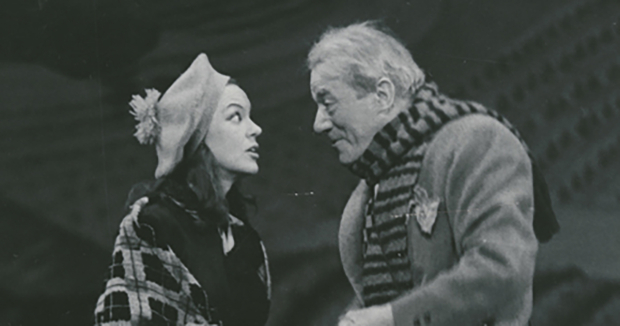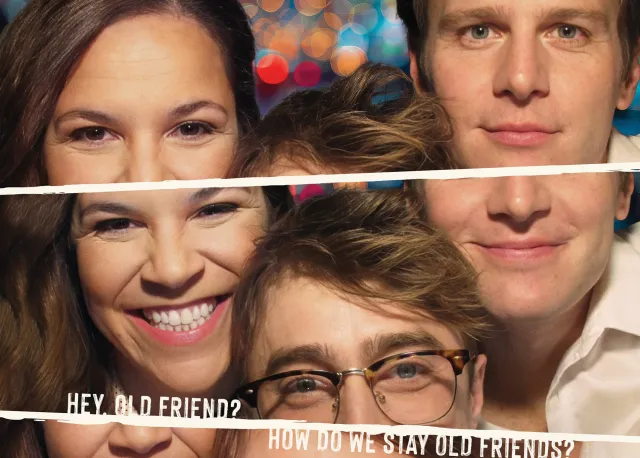When the Celts Overran Broadway: Reconsidering Brigadoon and Finian's Rainbow
These two musicals premiered in the same Broadway season, 75 years ago.

(© Fred Fehl/New York Public Library for the Performing Arts)
There was something Celtic in the air on Broadway 75 years ago, though there doesn't seem to be any particular rhyme or reason why two of the biggest musicals of the season appeared to be a competition between the Scots and the Irish. But that's what the winter of 1947 looked like with Finian's Rainbow having opened on January 10 and Brigadoon arriving just two months later on March 13.
Coming just a year and half after the end of World War II, it might appear that the two fantasies were both attempts to escape into flights of imagination as an antidote to the battles now ended. But revisiting the shows three-quarters of a century later, that doesn't seem to be the case, at least for one of them.
Brigadoon, with its imagined village that has magically stopped time, only coming to life every 100 years, more readily lends itself to the idea of a show designed to escape the realities that preceded it. The world had certainly moved on in the 200 years since the village vanished, but the musical doesn't speak to what has happened in those 200 years; the escape it offers is from the workaday modernized world.
Brigadoon itself didn't take its refuge due to battles between clans, but rather to escape the predations of witches, yet more magic. As Mr. Lundie, the schoolmaster, tells the modern-day hikers who accidently discover the town, "The Highlands of Scotland were plagued with witches; wicked sorcerers who were takin' the Scottish folk away from the teachin's of God an' putting the devil in their souls."
With a strong whiff of misogyny, he continued, "They were indeed horrible destructive women. I dinna suppose ye have such women in your world," to which the cynical Jeff replies, "Yes, we still have them. We pronounce it differently."
Even if one discounts the gender politics played for a laugh, the underlying message was that the impulse behind Brigadoon was less about an escape from worldly conflict, but rather a preservation of or return to spiritual purity, a "Brigadoon First" policy of isolation. This contrasted with the spirit that infused inhabitants of the many countries that had just spent half a decade banded together as "the Allies" to defeat the Nazi regime.

(© Fred Fehl/New York Public Library for the Performing Arts)
To be fair, that's applying heavy analysis on what makes up just a small portion of the swoony romance that suffuses Brigadoon – but political analysis of Finian's Rainbow is entirely fair and even demanded. While it also deploys magical spells – Og the leprechaun chases the Irishman Finian who stole his pot of gold to the United States – Finian's is a show that confronts racism and crooked politics while supporting the labor movement and questioning capitalism itself.
The fantasy of Finian's dreams of riches, which involves his garbled belief that burying gold near Fort Knox will allow it to grow, is rooted in a broader consideration of capitalism, with Finian's monetary theories invoking Karl Marx, albeit inaccurately, in his very first scene. That same capitalism fuels the schemes of the villain of the show, Senator Rawkins, who is trying to personally profit from a government plan to build a dam (a la the efforts of the Tennessee Valley Authority) that would require a significant purchase of property which would also dispossess the harmoniously multiracial community of Rainbow Valley where the musical is set. The town's defender is recently returned local boy Woody, a guitar strumming labor union organizer who clearly owes a debt to Woody Guthrie.
The progressive credentials of Finian's Rainbow are further demonstrated by its ridicule of Rawkins's racist attitudes towards the Black residents of Rainbow Valley, which include requiring a young Black man in his employ, a student in his final year at Tuskegee, to shuffle and drawl like some caricature of a slave. While the device by which Rawkins learns the impact of his racism, which sees him turned into a Black man, has not aged well (though recent productions avoid the blackface that once achieved the effect), it echoes the racial change from George Schuyler's 1931 satire Black No More and prefigures John Howard Griffin's 1961 Black Like Me.
Despite the elements that need to be finessed by modern productions in order to achieve the same effect in alignment with evolved sensibilities, parts of Finian's Rainbow seem evergreen. Chief among them is the bilious Rawkins's declaration, when a character asserts their rights and asks him whether he's ever read the US constitution, "I haven't got time to read it! I'm too busy defendin' it!"
At the first Tony Awards, before formal categories had been codified, both Brigadoon and Finian's Rainbow came up winners, with honors for their respective choreographers Agnes de Mille and Michael Kidd. David Wayne also received a Tony as Best Featured Actor in a Musical for his turn as Og, the only musical performer recognized in that first year. Save for short-run revivals under the auspices of City Center, each show has only had one full return to Broadway since the original productions: Brigadoon played the Majestic Theatre for eight previews and 133 performances in 1980-81, while Finian's Rainbow played the St. James Theatre for 22 previews and 92 performances in 2009-2010.
In the mists of memory and thanks to their concurrent original runs, Brigadoon and Finian's Rainbow are often lumped together, and possibly blurred in the minds of many, with their accents and their fantasies. But they are two very different works: one looking yearningly to the past, while the other is looking forward, to a better world at the end of the rainbow.








